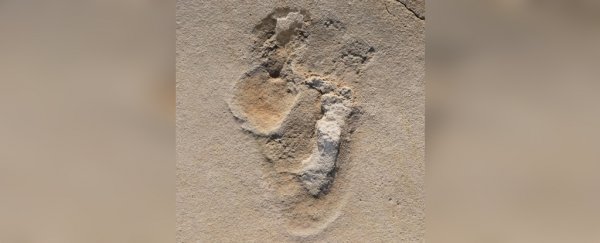Pre-human history is immensely hard to untangle. There are no early writings from the Neanderthals handily summarizing all the differences between the Australopithecus and the Orrorin.
While we're finding more ancient bones all the time, they're still very limited, making it difficult to analyze and catalogue fossil discoveries into one of the many species of Homo, Graecopithecus, and all the genera in between.
But bones aren't the only traces our hominin ancestors left behind – in some cases, their footprints were preserved in the sand.
As reported in 2017, a team of researchers found and analyzed a series of over 50 footprints on Trachiolos Beach on the Greek island Crete, which were thought to potentially be left by an ancient hominin-like creature from 5.7 million years ago.
A new study published this week now suggests that those hominin-like tracks are even older still – potentially as old as 6.05 million years old, making it 350,000 years older than originally thought.
There's no evidence of Homo sapiens in the fossil record anywhere before 300,000 years ago, and even our sister species Homo neanderthalensis only appeared around 430,000 years ago, so we're talking about our great-great-great (probably add a few more greats) ancestors here.
Australopithecus afarensis, an ancient primate better known from a preserved skeleton nicknamed Lucy, lived as early as 3.9 million years ago, so we're getting closer to the age range there.
In fact, this footprint is so old that the team suggest that Graecopithecus freybergi, a primate with tooth specimens thought to be 7.2 million years old (and potentially the oldest direct ancestor of humans, soon after our lineage parted ways with chimpanzees) could have had something to do with the footprints.
"We cannot rule out a connection between the producer of the tracks and the possible pre-human Graecopithecus freybergi," said University of Tübingen paleontologist Madelaine Böhme.
All of those ancient hominins would have had feet that differ in characteristics as we moved away from swinging in trees to walking upright full-time, and footprints allow us to analyze where in that process we were up to.
"This morphology includes characters that are currently considered [to] be unique to hominins such as the presence of a forefoot ball, a non-divergent and robust hallux placed alongside digit II on the distal margin of the sole and digits II through IV becoming progressively shorter," the team writes.
"These are combined with generic primate traits such as the absence of a longitudinal medial arch, a proportionately shorter sole and a heel that is not bulbous."
Not everyone agrees that it's an ancient hominin though, and when it comes to footprints, sometimes it can be hard to confirm an answer.
"This interpretation has been controversial, and several counter-interpretations have been made," the team writes.
"For example, Meldrum and Sarmiento suggested that the Trachilos tracks may have been made by a non-hominin primate with an adducted hallux and they illustrated this with reference to a gorilla footprint."
But the researchers maintain that none of the arguments have ruled out these tracks belonging to an early human ancestor like G. freybergi.
The dating of the fossil footprint was also in question, so the researchers set out looking specifically at the date of this site in the Platanos Basin and the Vrysses Group of northwestern Crete.
Using paleomagnetic and micropaleontological methods at Trachiolos Beach, the team analyzed 57 samples, which dated the footprints to older than previously calculated – approximately 6.05 million years ago.
These footprints, in case you've forgotten, were found on the island of Crete – not Africa. Although Crete would have been attached to mainland Greece at this point, it still throws up even more questions about where ancient hominins first evolved and adds some doubt to the commonly known 'out of Africa' theory.
As the researchers explain in their paper, "the evolutionary history and dispersal patterns of hominins are matters of debate".
"Despite numerous publications suggesting an origin in Africa, there are evidences that the earliest hominins might have evolved in Eurasia. Evidence for a Miocene hominin presence in Europe includes both body and trace fossils," they add.
When it comes to ancient human ancestors millions of years in the making, there's bound to be messy, complicated webs to untangle.
It looks like we're still discovering just how tangled our family tree can be.
The research has been published in Scientific Reports.
